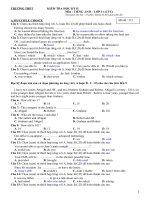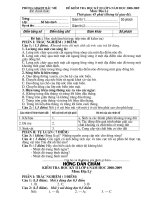- Trang chủ >>
- Văn bán pháp quy >>
- Chỉ thị
Đề thi và đáp án An toàn an ninh mạng kỳ 1 năm học 2014-2015 - UET - Tài liệu VNU
Bạn đang xem bản rút gọn của tài liệu. Xem và tải ngay bản đầy đủ của tài liệu tại đây (236.7 KB, 8 trang )
<span class='text_page_counter'>(1)</span><div class='page_container' data-page=1>
<i>Class : INT3093 No discussion or exchange of documents between students during the exam </i>
Final Exam Solution
<b>Network Security </b>
<i>(4 problems, 3 pages, point values given in parentheses, 10 maximum) </i>
<b>1. Key distribution and user authentication (2.5 points) </b>
<i>a. (1 point) </i>
<i>TS</i>1 allows AS to verify that the client’s clock is synchronized with that of AS.
In the case where the client’s clock is not synchronized with that of AS, for
example, suppose that the client’s clock is 2 hours later than the AS’ time, the
<i>lifetime for Tickettgs is only one hour, and the transmission time of message (2) is 1 </i>
<i>minute. Then, the client can never use Tickettgs. For example, at 9 am at the AS, </i>
<i>when the AS creates Tickettgs and sends message (2), the local time at the client is </i>
already 11 am. When the client receives message (2), the client’s time is 11:01 am,
while the ticket’s expiration time is 9 am + 1 hour = 10 am. That means when the
client receives the ticket, it has already expired.
<i>b. (0.5 point) </i>
<i>As the client C can’t decrypt Tickettgs to get TS</i>2<i> and Lifetime</i>2 inside it, AS needs
to add these fields outside the ticket so that the client C can learn its expiration
time.
<i>c. (1 point) </i>
Message (6) enables the client C to authenticate the service server V. Because the
message was encrypted by the session key, C is assured that it could have been
<i>created only by V. The inclusion of TS</i>5 in this message assure C that this is not a
<i>replay of an old message. There is nothing wrong if we replace TS</i>5<i> + 1 with TS</i>5. It
<i>is because the original timestamp TS</i>5 is also something that C has known in
<i>advance so it can also be used by C to verify the authenticity of message (6). TS</i>5 +
1 is used in Kerberos Version 4 simply to mean that message (6) is also an
<i>authenticator like AuthenticatorC and it is created at a time later than TS</i>5.
<b>2. Transport-level security (2.5 points) </b>
<i>a. (0.25 point) </i>
Write Read
Cnt Pnd Cnt Pnd
Encryption null ? null ?
MAC null ? null ?
</div>
<span class='text_page_counter'>(2)</span><div class='page_container' data-page=2>
IV null ? null ?
<i>b. (0.25 point) </i>
Write Read
Cnt Pnd Cnt Pnd
Encryption null ? null ?
MAC null ? null ?
Encr. key null ? null ?
MAC secret null ? null ?
IV null ? null ?
<i>c. (0.25 point) </i>
Write Read
Cnt Pnd Cnt Pnd
Encryption null DES null DES
MAC null MD5 null MD5
Encr. key null ? null ?
MAC secret null ? null ?
IV null ? null ?
<i>d. (0.25 point) </i>
Write Read
Cnt Pnd Cnt Pnd
Encryption null DES null DES
MAC null MD5 null MD5
Encr. key null ? null ?
MAC secret null ? null ?
IV null ? null ?
<i>e. (0.25 point) </i>
Write Read
Cnt Pnd Cnt Pnd
Encryption null DES null DES
MAC null MD5 null MD5
</div>
<span class='text_page_counter'>(3)</span><div class='page_container' data-page=3>
<i>f. (0.25 point) </i>
Write Read
Cnt Pnd Cnt Pnd
Encryption DES ? null DES
MAC MD5 ? null MD5
Encr. key 3456 ? null 4567
MAC secret 1234 ? null 2345
IV 5678 ? null 6789
<i>g. (0.25 point) </i>
Write Read
Cnt Pnd Cnt Pnd
Encryption null DES null DES
MAC null MD5 null MD5
Encr. key null 4567 null 3456
MAC secret null 2345 null 1234
IV null 6789 null 5678
<i>h. (0.25 point) </i>
Write Read
Cnt Pnd Cnt Pnd
Encryption null DES DES ?
MAC null MD5 MD5 ?
Encr. key null 4567 3456 ?
MAC secret null 2345 1234 ?
IV null 6789 5678 ?
<i>i. (0.25 point) </i>
Write Read
Cnt Pnd Cnt Pnd
Encryption DES ? DES ?
MAC MD5 ? MD5 ?
Encr. key 4567 ? 3456 ?
</div>
<span class='text_page_counter'>(4)</span><div class='page_container' data-page=4>
IV 6789 ? 5678 ?
<i>j. (0.25 point) </i>
Write Read
Cnt Pnd Cnt Pnd
Encryption DES ? DES ?
MAC MD5 ? MD5 ?
Encr. key 3456 ? 4567 ?
MAC secret 1234 ? 2345 ?
IV 5678 ? 6789 ?
<b>3. Electronic mail security (2.5 points) </b>
<b>4. IP Security (2.5 points) </b>
<i>a. (0,5 điểm) </i>
The receiver finds that the received packet falls within the replay window, but the
packet is not new, so it is discarded.
<i>b. (0,5 điểm) </i>
The receiver finds that the received packet is to the right of the replay window, so
the MAC is checked. As the packet is authenticated, the window is advanced so
that 457 is the right edge of the window, the correponding slot in the window is
marked, and the packet is accepted.
<i>c. (0,5 điểm) </i>
?
A
E
C
F
G
D
B
</div>
<span class='text_page_counter'>(5)</span><div class='page_container' data-page=5>
new, so the MAC is checked. As the packet is authenticated, the correponding
window is marked and the packet is accepted.
<i>d. (0,5 điểm) </i>
The receiver finds that the received packet is to the left of the window, therefore
the packet is discarded.
<i>e. (0,5 điểm) </i>
</div>
<span class='text_page_counter'>(6)</span><div class='page_container' data-page=6>
Duration : 120 minutes <i> Open books and notes, no notebooks, no mobile phones </i>
<i>Class : INT3093 No discussion or exchange of documents between students during the exam </i>
Final Exam
<b>Network Security </b>
<i>(4 problems, 3 pages, point values given in parentheses, 10 maximum) </i>
<b>1. Key distribution and user authentication (2.5 points) </b>
Consider the Kerberos Version 4 authentication dialogue.
<i>f. (1 point) </i>
<i>What is the rationale for the field TS</i>1 in message (1)? Give an example for why
<i>we need TS</i>1.
<i>g. (0.5 point) </i>
<i>What is the rationale for the fields TS</i>2<i> and Lifetime</i>2<i> located outside the Tickettgs </i>
structure in message (2)?
<i>h. (1 point) </i>
<i>What is the rationale for message (6)? Why is TS</i>5 used in this message? Is there
<i>anything wrong if we replace TS</i>5<i> + 1 with TS</i>5? Explain why.
<b>2. Transport-level security (2.5 points) </b>
As taught in the classroom, for any given system, whether it is a client or a server, SSL
defines a write state and a read state. The write state defines the security information for
data that the system sends, and the read state defines the security information for data that
the system receives. The matrices below show the systems’ initial read and write states.
Client Server
Write Read
Cnt Pnd Cnt Pnd
Encryption null ? null ?
MAC null ? null ?
Encr. key null ? null ?
MAC secret null ? null ?
IV null ? null ?
Write Read
Cnt Pnd Cnt Pnd
Encryption null ? null ?
MAC null ? null ?
Encr. Key null ? null ?
MAC secret null ? null ?
IV null ? null ?
</div>
<span class='text_page_counter'>(7)</span><div class='page_container' data-page=7>
and the IV (Initialization Vector).
Suppose that by executing the SSL Handshake protocol, the systems agree to use the
Data Encryption Standard (DES) for symmetric encryption and Message Digest 5 (MD5)
for message integrity. The client write MAC secret, the server write MAC secret, the
client write encryption key, the server write encryption key, the client write IV, and the
server write IV are 1234, 2345, 3456, 4567, 5678, and 6789, respectively.
<i>k. (0.25 point) </i>
<i>Write the matrix describing the client’s states after sending the client_hello </i>
<i>message and before receiving the server_hello message. </i>
<i>l. (0.25 point) </i>
<i>Write the matrix describing the server’s states before receiving the client_hello </i>
message.
<i>m. (0.25 point) </i>
<i>Write the matrix describing the server’s states just after sending the server_hello </i>
message.
<i>n. (0.25 point) </i>
<i>Write the matrix describing the client’s states just after receiving the server_hello </i>
message.
<i>o. (0.25 point) </i>
Write the matrix describing the client’s states just before sending the
<i>change_cipher_spec message. </i>
<i>p. (0.25 point) </i>
Write the matrix describing the client’s states after sending the
<i>change_cipher_spec message and before sending the finished message. </i>
<i>q. (0.25 point) </i>
Write the matrix describing the server’s states just before receiving the
<i>change_cipher_spec message. </i>
<i>r. (0.25 point) </i>
Write the matrix describing the server’s states after receiving the
<i>change_cipher_spec message and before receiving the finished message. </i>
<i>s. (0.25 point) </i>
Write the matrix describing the server’s states after sending the
<i>change_cipher_spec message and before sending the finished message. </i>
<i>t. (0.25 point) </i>
Write the matrix describing the client’s states after receiving the
</div>
<span class='text_page_counter'>(8)</span><div class='page_container' data-page=8>
<b>3. Electronic mail security (2.5 points) </b>
<b>A user A maintains a PGP public key ring with the fields Public Key, User ID, Owner </b>
<b>Trust, and Signatures as follows: </b>
<b>Public </b>
<b>Key </b>
<i>PU</i>A <i>PU</i>B <i>PU</i>C <i>PU</i>D <i>PU</i>E <i>PU</i>F <i>PU</i>G <i>PU</i>H
<b>User ID </b> A B C D E F G H
<b>Owner </b>
<b>Trust </b>
<i>Ultimate Usually </i>
<i>trusted </i>
<i>Usually </i>
<i>trusted </i>
<i>Not </i>
<i>trusted </i>
<i>Always </i>
<i>trusted </i>
<i>Always </i>
<i>trusted </i>
<i>Always </i>
<i>trusted </i>
<i>Not </i>
<i>trusted </i>
<b>Signatures </b> - A B, E, I B, C A, H G, B D F
<b>The Key Legitimacy fields are computed on the basis of the attached signatures as </b>
follows:
<i> If the owner is A then the public key is legitimate. </i>
<i> If at least one signature has a signature trust value of ultimate, then the public key is </i>
<i>legitimate. </i>
Otherwise, PGP computes a weighted sum of the trust values. A weight of 1 is given
<i>to signatures that are always trusted and ½ to signatures that are usually trusted. </i>
<b>When the total of weights of the introducers of a Public Key/User ID combination </b>
<i>reaches 1, the public key is considered legitimate. </i>
<i> In all remaining cases, the public key is considered illegitimate. </i>
Draw the corresponding PGP trust model.
<b>4. IP Security (2.5 points) </b>
Suppose that the current replay window spans from 200 to 455. The receiver has received
all the packets with odd sequence numbers in the replay window but none with even
sequence numbers. What will the receiver do with each of the following packets?
<i>a. (0,5 điểm) </i>
A non-authenticated packet with sequence number 455.
<i>b. (0,5 điểm) </i>
An authenticated packet with sequence number 457.
<i>c. (0,5 điểm) </i>
An authenticated packet with sequence number 202.
<i>d. (0,5 điểm) </i>
An authenticated packet with sequence number 201.
<i>e. (0,5 điểm) </i>
A non-authenticated packet with sequence number 202.
</div>
<!--links-->
Đề thi và đáp án Địa 11 - HK 1 2008-2009
- 4
- 833
- 6








